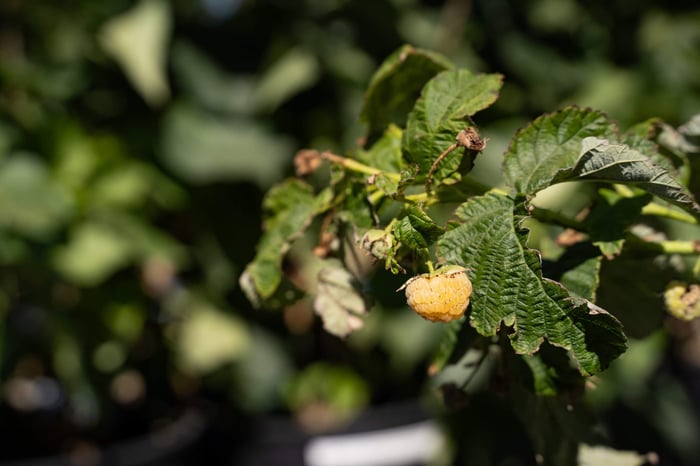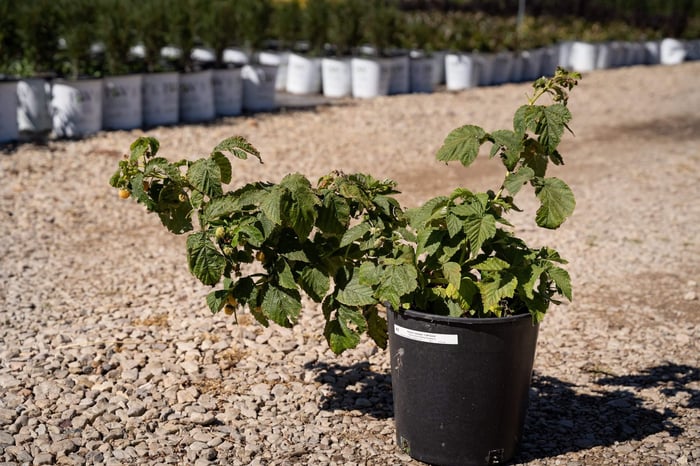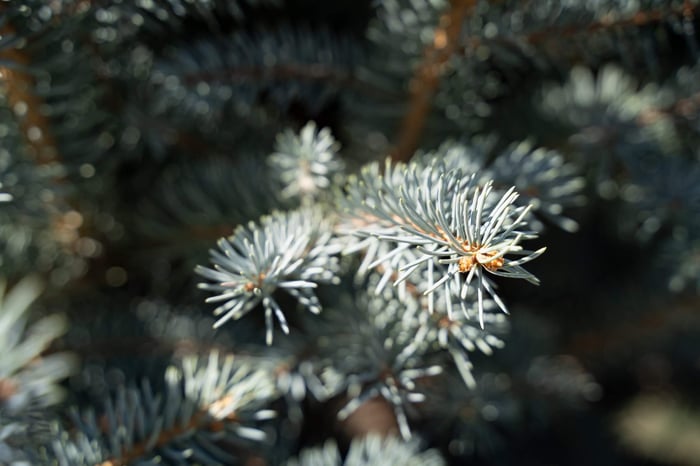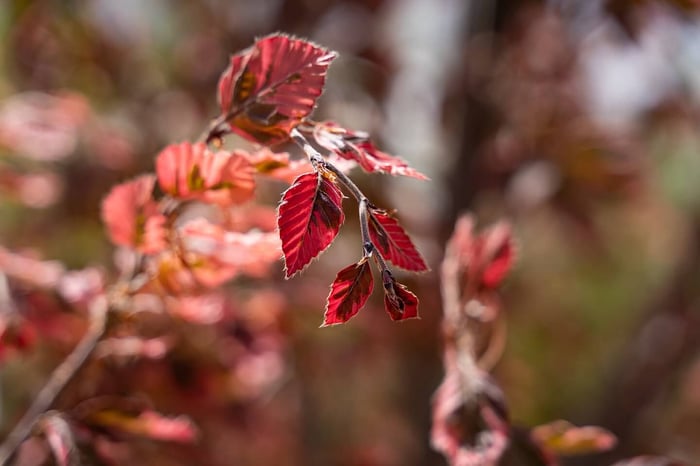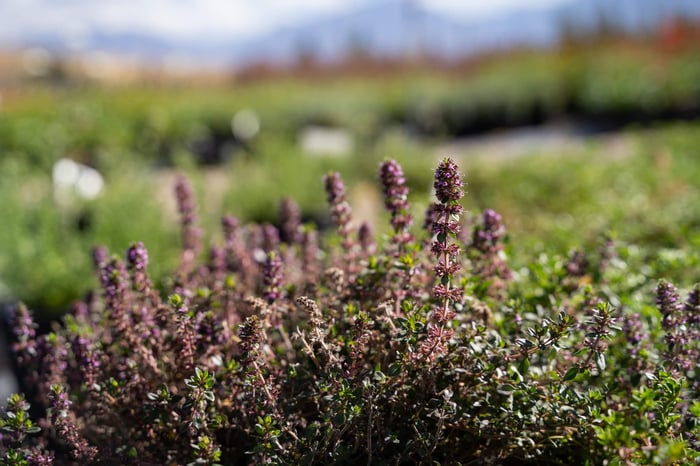Golden Harvest
When it comes to raspberries, local gardeners swear by the yellow ones! There’s something irresistible about a sun‑warmed, pale‑gold raspberry picked at peak ripeness. Rubus idaeus 'Fall Gold', commonly called Yellow‑Gold Fruiting Raspberry, adds a luminous, cheerful note to edible borders, cottage beds, and mixed hedgerows in the Intermountain West (Utah, Idaho, Wyoming, and Colorado). If you're looking for a fantastic, extra sweet raspberry that will thrive in our high, dry, and often alkaline landscapes, this variety can be a reliable and satisfying producer. You just need a little regional know‑how.
What makes 'Fall Gold' special?
'Fall Gold' offers bright, aromatic yellow fruits that stand out in beautiful contrast against its dark foliage, but its best known for its extra sweet flavor. These raspberries work beautifully in desserts and preserves, that is, if you can ever get them that far. They're often snatched up immediately and eaten fresh. 'Fall Gold' tends to be a primocane (fall‑fruiting) type in many climates, giving a late‑summer to autumn crop on current-season canes. That makes them perfect for our short growing season and ideal for fall planting.
Site selection & sun
Sun: Full sun is best for maximum fruit set. Six or more hours is ideal, but in the hottest valley sites you can tuck plants in spots where they'll receive some relief from the afternoon heat. At higher elevations, more sun is ideal to maximize ripening during our brief summers.
Wind & microclimate: To reduce winter desiccation, place plants on the side of fences, hedges, or buildings that offer protection from wind. A south or southeast exposure warms the soil earlier in spring and helps the fruit ripen faster, but that is also where they will get the hottest sun and strongest winds. With a little planning you can create an ideal location that can take advantage of that early spring sun while still providing some heat and wind protection.
Soil and pH—dealing with alkaline conditions
Raspberries prefer slightly acidic to neutral soils, but 'Fall Gold' will perform in our alkaline soils with just a little preparation:
Test your soil. If pH is high, plant in raised beds or large containers filled with a well‑drained loamy mix amended with plenty of compost. Raised beds also warm faster in spring and drain better in clay soils.
In heavy valley clay, add generous compost to improve your soil structure. Organic matter is key, but if you'd like, you can also and coarse sand, vermiculite, or pumice. Gypsum can help improve structure of clay soil as well, but it won’t lower pH.
If iron chlorosis (yellowing between veins) appears, use iron chelates as a foliar or soil treatment and increase organic matter. If you want to engage in a long-term project, you could also add elemental sulfur in an effort to lower your soil's pH. Remember, however that you're fighting an uphill battle. The alkalinity of our soil is practically perpetual. Even if you were able to neutralize the pH, our dry summers lead to significant evaporation, drying out water that leaves minerals behind. Plus, because all of the secondary water in Utah comes from sources that travel through our mineral and calcium-rich mountains, that water picks up dissolved solids on its way to our reservoirs--which means each drop of secondary water you give your plants increases the pH of your soil. In fact, water from Utah Lake, is so heavy with dissolved solids, it's actually poisonous to many plants.
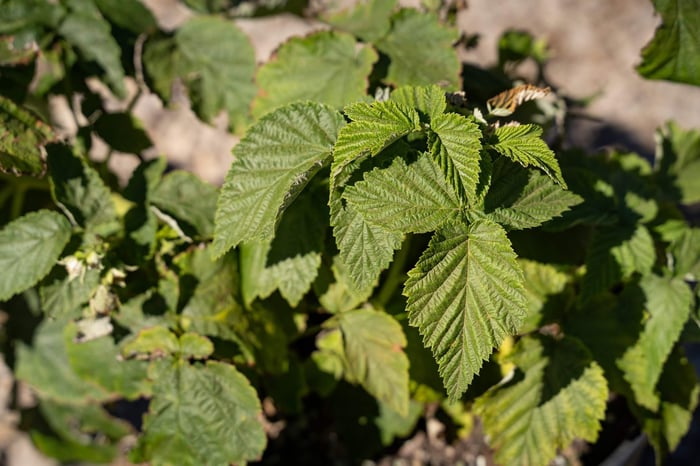
Water and water‑wise care
Because Fall Gold has moderate water requirements, it's best to water infrequently and deeply. In our hot, dry summers 1 to 2 deep soakings per week (adjust for elevation and soil type) are better than daily shallow watering. Use drip irrigation or soaker lines and mulch heavily (4 inches of organic mulch like straw or shredded bark) to conserve soil moisture, moderate soil temperature, and protect roots in winter.
Planting, spacing, and training
Plant the crowns 2 to 3 feet apart with rows 6 to 8 feet apart for good air flow. Good spacing reduces disease risk and improves berry quality.
Install a simple trellis or wires (two wires at 3' and 4') to support canes and make picking easier.
Fall is our second and often best planting season. Cooler temperatures and seasonal rains help roots establish before winter. Plant at least 4 to 6 weeks before the average first hard freeze so roots have time to settle.
Pruning for fall fruit
Because 'Fall Gold' is typically a primocane (fall‑fruiting) type, the easiest method for a single, abundant fall crop is to prune all canes to the ground in late winter/early spring, allowing new canes to grow and bear on that year's wood. If you want both a summer crop and an autumn crop, keep some floricanes and remove others in a two‑row, staggered system—this takes more management but stretches your harvest.
Pests, diseases & regional cautions
Keep canes pruned and thinned for air flow to reduce cane blight and powdery mildew.
Avoid poorly drained sites to prevent root rot; raised beds are an excellent solution in heavy clay.
Watch for spider mites in hot, dry summers—maintain mulch and occasional targeted control if needed.
Protect ripening fruit from birds with netting; harvest frequently to discourage pests.
Hopefully, we've given you all the information you need to confidently plant Yellow-Gold Fruiting Raspberries in your garden. If you have any questions or would like to know more about what will grow in your area, please contact us. We're open year-round and are more than happy to share our experience with you. Good luck, and happy gardening!

